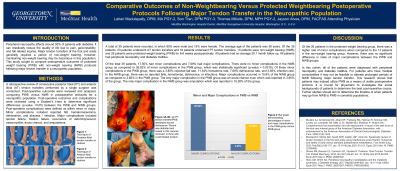Clinical Research
(DLS-038) Comparative Outcomes of Non-Weightbearing Versus Protected Weightbearing Postoperative Protocols Following Major Tendon Transfer in the Neuropathic Population
Friday, April 28, 2023
7:15 PM - 8:30 PM East Coast USA Time

Jayson Atves, DPM; Lahari Madulapally, DPM; Thomas Milisits, DPM
Introduction: Major tendon transfer of the foot and ankle generally requires a period of non-weight bearing, however, maintaining non-weight bearing may be hazardous in certain populations. This study sought to compare postoperative outcomes of protected weight bearing (PWB) with non-weight bearing (NWB) protocols following major tendon transfer in a neuropathic population.
Methods: A retrospective review of consecutive posterior tibial (PT) and anterior tibial (AT) tendon transfers performed by a single surgeon was executed. Post-operative outcomes were reviewed and analyzed, specifically comparing protected weight-bearing versus non-weight bearing postoperative protocols.
Results: A total of 39 patients were recruited, including 23 AT tendon transfers and 16 PT tendon transfers. 13 patients were non-weight bearing (NWB) and 26 patients were protected weight bearing (PWB), for 6-8 weeks postoperatively. All patients had an average 20.1 month followup. All patients had peripheral neuropathy and diabetes mellitus. No minor complications were reported in the NWB group as compared to 26.92% in the PWB group, which was statistically significant (p-value = 0.0318). Major complications occurred in 15.8% of the NWB group as compared to 3.85% in the PWB group. There was also a higher reported fall rate for the PWB (3.9%) versus NWB (0.0%).
Discussion: The PWB group observed a higher rate of minor complications compared to the NWB group, although there was no significant difference in rates of major complications. This cohort indicates that patients who may not feasibly tolerate prolonged periods of NWB following major tendon transfer may instead utilize PWB as a means of viable postoperative protocol.
Methods: A retrospective review of consecutive posterior tibial (PT) and anterior tibial (AT) tendon transfers performed by a single surgeon was executed. Post-operative outcomes were reviewed and analyzed, specifically comparing protected weight-bearing versus non-weight bearing postoperative protocols.
Results: A total of 39 patients were recruited, including 23 AT tendon transfers and 16 PT tendon transfers. 13 patients were non-weight bearing (NWB) and 26 patients were protected weight bearing (PWB), for 6-8 weeks postoperatively. All patients had an average 20.1 month followup. All patients had peripheral neuropathy and diabetes mellitus. No minor complications were reported in the NWB group as compared to 26.92% in the PWB group, which was statistically significant (p-value = 0.0318). Major complications occurred in 15.8% of the NWB group as compared to 3.85% in the PWB group. There was also a higher reported fall rate for the PWB (3.9%) versus NWB (0.0%).
Discussion: The PWB group observed a higher rate of minor complications compared to the NWB group, although there was no significant difference in rates of major complications. This cohort indicates that patients who may not feasibly tolerate prolonged periods of NWB following major tendon transfer may instead utilize PWB as a means of viable postoperative protocol.

.png)
